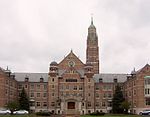Highbanks Metro Park
1973 establishments in OhioNational Natural Landmarks in OhioNature centers in OhioParks established in 1973Parks in Ohio ... and 2 more
Protected areas of Delaware County, OhioProtected areas of Franklin County, Ohio

Highbanks Metro Park is a metropolitan park in Central Ohio, owned and operated by Columbus and Franklin County Metro Parks. The park is named for its steep banks along the Olentangy River, the park's most unique feature. Highbanks also features ten trails, picnic space, a nature center, sledding hill, and nature preserve. It also includes numerous ancient burial mounds and earthworks from the indigenous Adena culture. The park was established in 1973, and named a National Natural Landmark seven years later. In 2017, the park's River Bluff Area opened to the public.
Excerpt from the Wikipedia article Highbanks Metro Park (License: CC BY-SA 3.0, Authors, Images).Highbanks Metro Park
Overlook Trail (2.3 mi), Orange Township
Geographical coordinates (GPS) Address Nearby Places Show on map
Geographical coordinates (GPS)
| Latitude | Longitude |
|---|---|
| N 40.145365 ° | E -83.027064 ° |
Address
Overlook Trail (2.3 mi)
Overlook Trail (2.3 mi)
43085 Orange Township
Ohio, United States
Open on Google Maps






